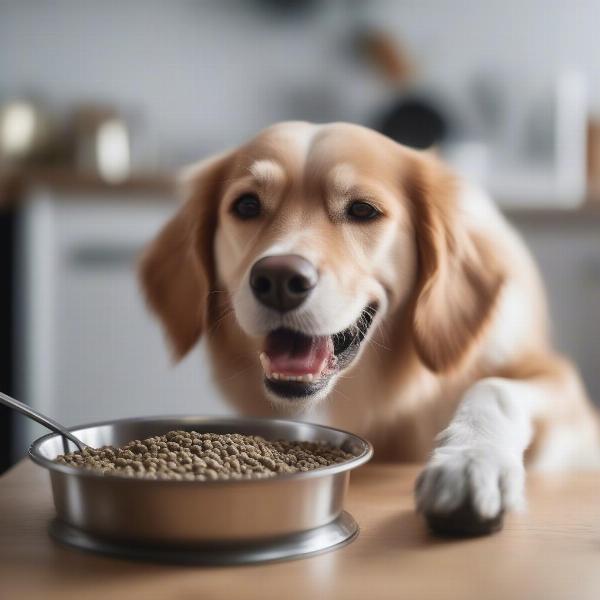Woofin’ good dog food is essential for a happy and healthy pup. Choosing the right food can seem daunting with so many brands, formulas, and marketing claims out there. This guide will equip you with the knowledge you need to navigate the world of dog food and select the best diet for your furry friend’s specific needs, whether they’re a playful puppy or a wise senior.
Decoding Dog Food Labels: What to Look For
Understanding dog food labels is crucial for making informed decisions. Don’t be fooled by fancy packaging and marketing jargon. Focus on the ingredients list, guaranteed analysis, and the AAFCO (Association of American Feed Control Officials) statement. The ingredients are listed in descending order by weight, so the first few ingredients are the most prominent in the food. Look for whole meat sources, like chicken, beef, or fish, as the primary ingredients. Avoid fillers like corn, wheat, and soy, which offer little nutritional value. The guaranteed analysis provides minimum percentages of crude protein, fat, fiber, and moisture.
The AAFCO statement indicates whether the food meets the minimum nutritional requirements for a complete and balanced diet for a specific life stage (e.g., growth, adult maintenance, all life stages). Look for a statement that says the food meets AAFCO nutrient profiles, as this is based on feeding trials.
What is “Woofin’ Good” Dog Food Anyway?
The phrase “woofin’ good” implies a highly palatable and enjoyable food for dogs. While palatability is important to ensure your dog actually eats their food, it shouldn’t be the only factor. “Woofin’ good” should also mean nutritionally complete and balanced, providing all the necessary vitamins, minerals, and other nutrients for optimal health.
 A Happy Dog Enjoying a Meal
A Happy Dog Enjoying a Meal
Different Types of Dog Food: Dry, Wet, Raw, and Home-cooked
Dry kibble is the most popular type due to its convenience and affordability. Wet food is higher in moisture and can be more appealing to picky eaters. Raw and home-cooked diets are gaining popularity but require careful planning and preparation to ensure nutritional balance. Consult with your veterinarian before switching to a raw or home-cooked diet.
Life Stage Nutrition: Puppy, Adult, Senior
Puppies require a higher calorie and protein diet to support their rapid growth. Adult dogs need a balanced diet to maintain their weight and energy levels. Senior dogs may benefit from a lower calorie, higher fiber diet with added joint support supplements.
Special Dietary Needs and Considerations
Some dogs have allergies or sensitivities that require specialized diets. Common allergens include beef, chicken, dairy, and grains. If your dog exhibits signs of allergies, such as itching, digestive upset, or skin infections, consult your veterinarian for diagnosis and dietary recommendations.
How to Transition to a New Dog Food
When switching your dog to woofin’ good dog food, do so gradually over several days to avoid digestive upset. Start by mixing a small amount of the new food with the old food, gradually increasing the proportion of new food over time.
Is Woofin’ Good Dog Food Right for Your Dog?
Ultimately, the best woofin’ good dog food is the one that meets your dog’s individual needs and preferences. Consider their age, breed, activity level, and any health conditions. Don’t be afraid to experiment with different brands and formulas until you find the perfect fit.
Conclusion
Choosing woofin’ good dog food is a crucial part of responsible pet ownership. By understanding dog food labels, considering your dog’s individual needs, and consulting with your veterinarian, you can ensure your furry friend receives the optimal nutrition they deserve.
FAQ
- How often should I feed my dog? Most adult dogs thrive on two meals per day.
- How much food should I give my dog? Follow the feeding guidelines on the dog food label, but adjust the amount based on your dog’s individual needs and activity level.
- What are some signs of food allergies in dogs? Common signs include itching, skin infections, digestive upset, and ear infections.
- Can I give my dog human food? Some human foods are safe for dogs in moderation, but others are toxic and should be avoided. Consult with your veterinarian before giving your dog any human food.
- How do I store dog food? Store dry kibble in a cool, dry place in an airtight container. Refrigerate opened cans of wet food.
- Is it okay to switch dog food brands? Yes, but do so gradually to avoid digestive upset.
- What should I do if my dog refuses to eat their new food? Try mixing it with their old food or adding a small amount of warm water or low-sodium broth.
You Might Also Like These Articles:
- [Link to relevant article on ilmdog.com about dog nutrition]
- [Link to relevant article on ilmdog.com about dog health]
About ILM Dog
ILM Dog (ilmdog.com) is your global resource for expert dog care advice. From breed selection and puppy care to senior dog health and training tips, we offer comprehensive and practical guidance for dog owners of all experience levels. Our team of experts covers a wide range of topics, including nutrition, behavior, grooming, and product reviews, to help you make the best decisions for your beloved companion. Contact us for personalized support: Email: [email protected], Phone: +44 20-3965-8624.